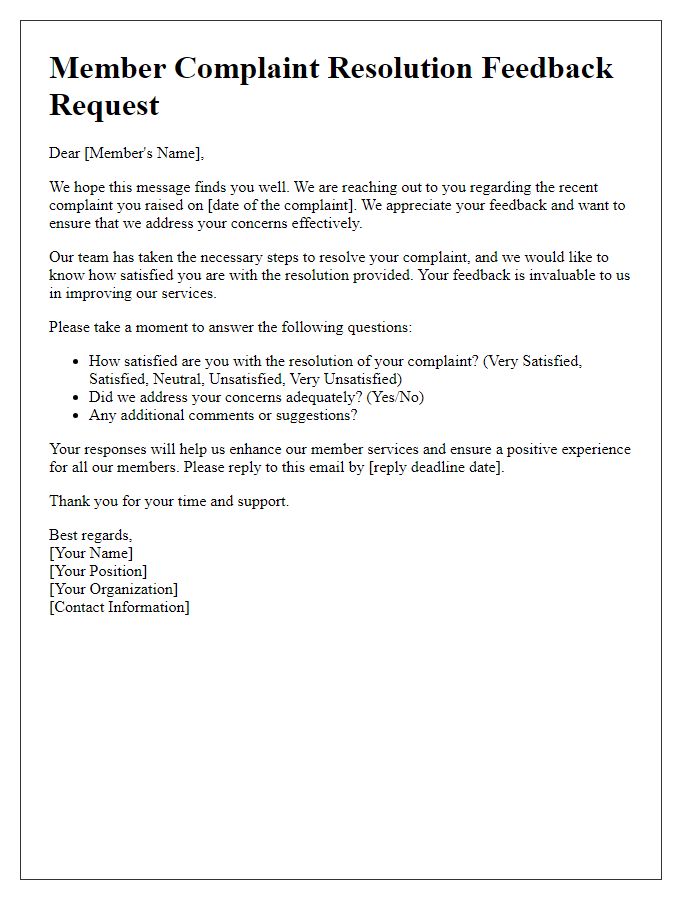Are you looking for a way to effectively address member complaints while maintaining a positive relationship? Crafting a thoughtful letter can not only resolve the issue at hand but also strengthen your connection with your members. In this article, we'll explore a comprehensive letter template designed to address grievances while ensuring your members feel heard and valued. Join us as we dive deeper into the steps for creating an impactful resolution letter!

Clear identification of the complaint issue
The resolution of member complaints is critical to maintaining a positive community environment. Specific issues often arise, such as member disputes (reported incidents within the last quarter), payment discrepancies (accounting errors leading to financial grievances), or service quality concerns (dissatisfaction with amenities like internet connectivity or cleanliness). Each complaint must be documented thoroughly, including member identification (name, membership number), date of the complaint (specific timestamp), and detailed description of the issue (evidence like email correspondence or incident reports). Additionally, establishing a timeline for resolution (promising follow-up within seven business days) and outlining the steps for addressing complaints (investigation process involving management review) can significantly enhance member satisfaction and trust in organizational processes.
Empathetic acknowledgment of member's concerns
Members experiencing dissatisfaction can feel a range of emotions, especially when concerns remain unaddressed. Acknowledging those feelings is crucial in creating an environment of trust and understanding. For example, a member may express frustration regarding delayed responses to inquiries about their billing statements in monthly club meetings and can feel undervalued due to lack of personalized attention. Validating their concerns reinforces that the organization recognizes the importance of member experiences and is committed to resolving issues promptly. By openly empathizing with members about their negative encounters, organizations can foster a culture of transparency and customer care, thereby enhancing overall satisfaction and retention.
Step-by-step explanation of the resolution process
Receiving a member complaint initiates a structured resolution process designed to ensure transparency and effectiveness. The first step involves acknowledging the complaint promptly, ideally within 24 hours, signaling to the member that their concerns are being taken seriously. Following the acknowledgment, the next stage requires gathering detailed information about the incident, including specific events, timelines, and the individuals involved, often through a member's account of the issue and documentation, such as emails or reports. Once sufficient data is collected, a thorough investigation ensues, typically involving discussions with relevant parties to gain multiple perspectives. This investigative phase can last from several days to a few weeks, depending on the complexity of the complaint. After concluding the investigation, a resolution is formulated based on findings, prioritizing fairness and adherence to organizational policies. The final step entails communicating the resolution to the member clearly, explaining the rationale along with any actions taken to prevent future occurrences, and inviting further dialogue if needed to ensure member satisfaction.
Assurances of future preventative measures
Company policies are essential for addressing member complaints, especially regarding customer service issues. A thorough investigation (involving team members and timestamps of interactions) is crucial for understanding the context and resolution process. Implementing future preventative measures includes staff training sessions aimed at improving communication skills. Regular feedback loops (monthly surveys or quarterly assessments) can ensure ongoing improvements. Furthermore, establishing a dedicated complaint resolution team enhances accountability and responsiveness, fostering a supportive environment within the organization. These initiatives aim to enhance the overall experience for members and prevent similar issues from arising in the future.
Contact information for further assistance
The resolution process of member complaints often involves timely and clear communication. Immediate contact information, such as a dedicated complaints resolution email (e.g., support@community.org) or a direct phone line (e.g., +1-800-555-0199), is crucial for members seeking further assistance. Members may need access to an online portal or helpdesk (e.g., help.community.org) that provides additional resources or FAQs regarding their concerns. Department hours of operation (e.g., weekdays from 9 AM to 5 PM EST) ensure members can reach out at the most convenient times, fostering a supportive environment that values member feedback and encourages continuous improvement in services.













Comments